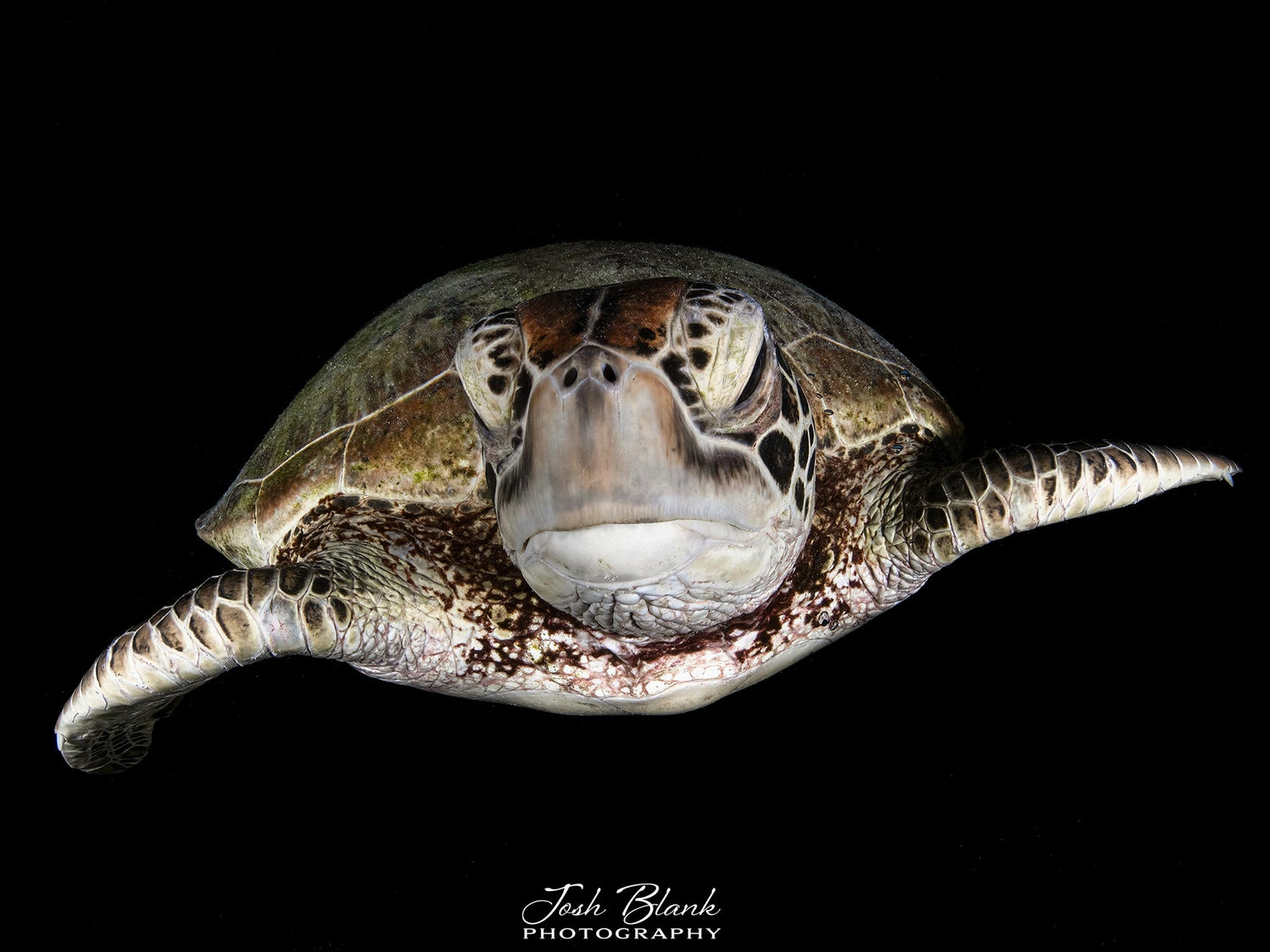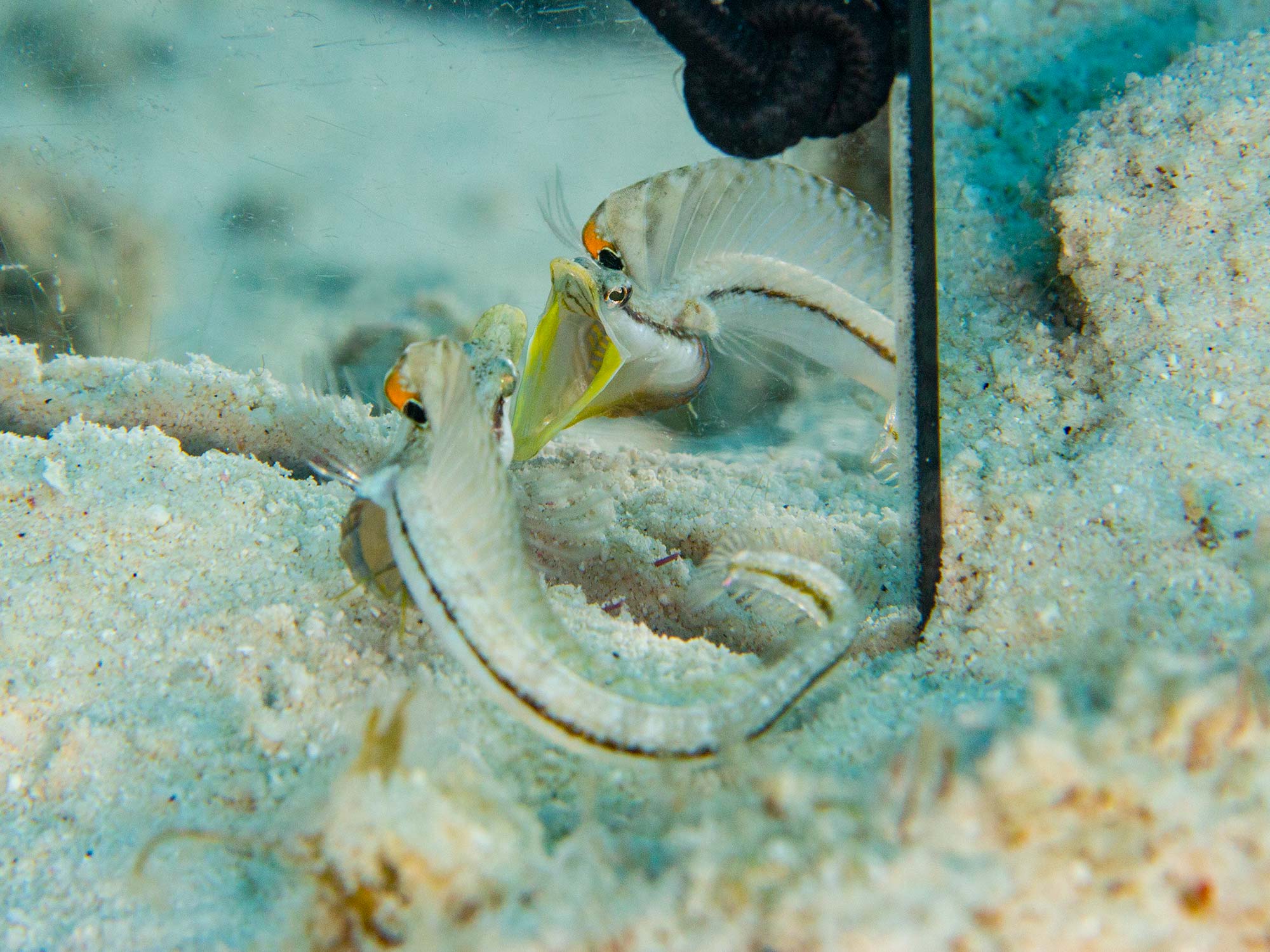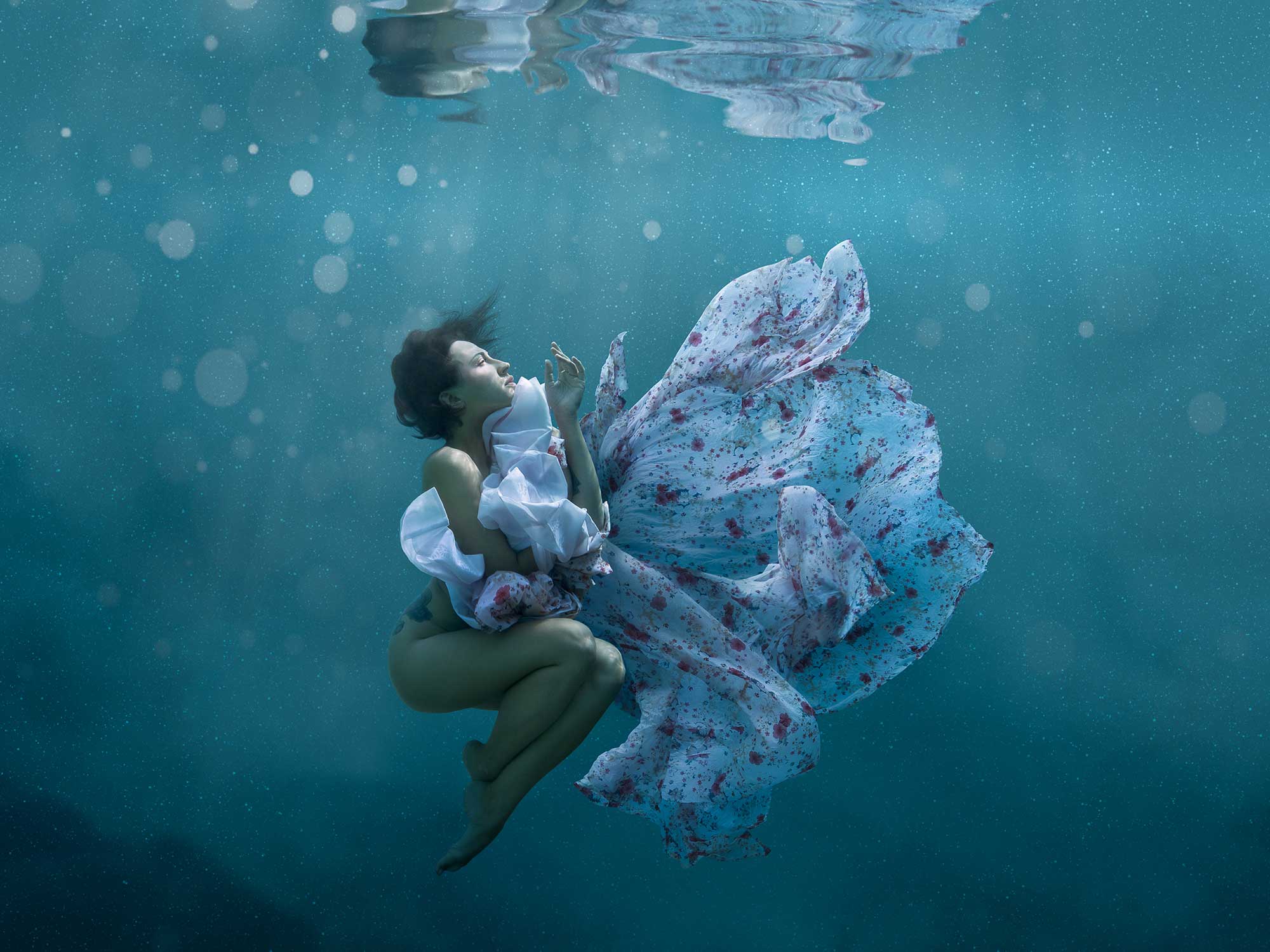By Josh Blank
When it comes to underwater photography, animal portraits are among some of the most popular types of images. A nicely exposed, detailed close-up has the power to spark interest, invoke emotion and inspire others to learn more about the underwater world we all love so much.
In order to create a beautiful animal portrait, photographers should understand the importance of composition and how best to emphasise the subject and its surroundings, the benefits of specific cameras, lenses, and lighting equipment, as well as practical techniques to achieve eye-catching imagery.
Underwater animal portraiture is a great passion of mine and in fact makes up a vast majority of my portfolio. I believe there is nothing more rewarding than capturing the nature and essence of a particular species and portraying them in a way that excites and intrigues others!

Animal portraits have a way of connecting with people as they often portray the subject’s demeanour. This green sea turtle was checking himself out in the reflection of my dome port. F9 • 1/200 • ISO 400. © 2022 Josh Blank
What is Animal Portraiture?
Animal portraits are any image that focuses primarily on the species and captures them in a way that highlights their key characteristics and features.
These photos are often very impactful as they have the ability to reveal details and textures not commonly seen. Think of the iconic teeth of a grey nurse shark or the inquisitive eye of a minke whale; these are the kind of details that are possible to capture through animal portraits.

Animal portraits often focus on iconic features of a subject such as the eye of a dwarf minke whale. F5.6 • 1/250 • ISO 400. © 2022 Josh Blank
Ethical Considerations
Before going further and getting into the technical side of things, it’s important to touch on the ethical considerations when shooting portraits.
Part of capturing these types of images involve getting very close to your subjects which can have an adverse effect if you’re not careful. Always approach the animal slowly and observe how it reacts to your presence before moving in to take a photo. If the animal swims away as you get closer, it is always best to find another subject. This is true from both an ethical standpoint, as well as from a photography point of view; for the vast majority of subjects, if they don’t want their photo taken it will be just about impossible to capture an image worth keeping!
It is also important to always be mindful of your surroundings. Many underwater species are found in delicate environments such as coral reefs. As photographers, we must never attempt an image unless we are confident we can do so without harming the environment.

Many subjects live amongst delicate reef systems such as this moray eel. Always be aware of your surroundings and ensure no harm is done. F8 • 1/200 • ISO 100. © 2022 Josh Blank
What Makes a Good Animal Portrait?
The answer to this question is of course a subjective one and will vary between photographers. For me personally, a nice portrait is one that portrays an animals most unique and intriguing features in a way that enhances their aesthetics. I aim to ensure the subject largely fills the frame and that there is a strong emphasis on sharpness, textures and details. The background can also be a powerful tool to either add to the image or draw even more attention to your subject.
Details are Key
For the most part, the best animal portraits all have one thing in common; that is, a crazy attention to detail. As ocean photographers we are lucky that our subjects often possess a number of interesting features including curious eyes, brutal mating scars and formidable teeth just to name a few. Capturing these types of details will take your portrait photography to a whole other level.
Various ocean species also have iconic features such as a shark’s dorsal fin, a green sea turtles shell or a whale’s tail. Be sure to keep these in mind when composing your next portrait.

Focus on the details! This green sea turtle got nice and close allowing me to highlight the intricate details around its eye. F8 • 1/250 • ISO 320. © 2022 Josh Blank
Consider the Background
Animal portraits primarily focus on the subject, however, it’s important to not neglect the background as it can be used to further enhance an image.
While filling the frame with your subject is necessary, its helps to also consider the background when composing. Turbulent water on the surface, rocky or reef surroundings, and even other marine species can be included provided it doesn’t take the focus away from your subject.
On the other hand, removing the background entirely by rendering it black can help direct even more focus onto your subject. This is best achieved in camera by shooting with fast shutter speeds, narrow apertures (high F number) and strobe lighting, however, can also be completed using post-production software such as photoshop.

Black backgrounds are a great way to put further focus on your subject. A combination of fast shutter speeds, narrow apertures, strobes, and low light conditions will help create this effect. F20 • 1/320 • ISO 400. © 2022 Josh Blank
Equipment Recommendations for Underwater Animal Portraits
Camera
A nice underwater portrait can be captured using any camera available today, however, certain features and capabilities can assist in both enhancing your images as well as improve your chances of capturing that one perfect frame.
One consideration is your cameras sensor size. Typically, a larger sensor such as those found in full frame DSLR or mirrorless systems, is capable of capturing images in greater resolution and detail; this is an advantage when it comes to portraits where details and textures are crucial. Additionally, large sensors will typically perform better in low light scenarios such is the case when diving.
Another consideration is the speed at which your camera can fire in continuous shooting mode. Whilst this is not always necessary, photographing fast moving subjects, such as sharks or dolphins, can be tricky and having a camera capable of firing at 7 frames per second or quicker can greatly improve your chances of a nice composition.

A camera capable of shooting multiple frames per second can be a big advantage when it comes to creating portraits of the faster fish in the sea like this short fin mako. F8 • 1/2000 • ISO 1250. © 2022 Josh Blank
Lens
For portraits of the larger marine species, such as turtles, sharks, dolphins and bigger, you will require a lens that has both a wide field of view as well as a very close focussing distance. This will allow you to get close enough to your subject while still filling the frame to create captivating images.
If shooting with a full frame camera, Nikon and Canon’s 8-15mm fisheye lens is an excellent choice. If working with a cropped sensor camera, the ever-popular Tokina 10-17 will produce beautiful results.
If you’re looking to photograph smaller species you will want a lens with much greater reach enabling you to capture all of the intricate details on tiny critters such as nudibranchs. Nikons 60mm or 105mm are common choices as well as the 100mm from Canon.

Nikon’s 8-15mm fisheye lens allowed me to capture this very playful sea lion as it came just inches from my dome port. F8 • 1/500 • ISO 320. © 2022 Josh Blank
Strobe Lighting
Strobe lighting is not a requirement when it comes to creating beautiful underwater images, however, they are extremely useful and can often be the difference between a good and great image.
In short, the deeper you descend the more colour is lost and photographs will begin to look overly blue and green as well as lose sharpness and detail. Strobe lighting uses short powerful bursts of light to reintroduce these colours and details to make a more impactful image.
Ikelite strobes are industry leading with stunning temperature (colour), impressive power and fast recycle speeds. The DS160, DS162 and DS230 are all excellent options (see strobes here).

A giant Australian cuttlefish captured with dual Ikelite DS160 strobes. Strobes allowed me to shoot towards the sun while retaining the natural colours of the cuttlefish.
In-Water Tips for Animal Portraits
Ocean imagery in general is quite difficult with often tricky shooting conditions and marine life that simply doesn’t want to know you! It takes a lot of practice and perseverance to capture animal portraits underwater. As challenging as it can be, there are a few tips and tricks you can use to help create something impressive.
Get as Close as Possible!
This is a common one in the world of ocean photography. When it comes to portraits you will want to be as close as you can be to your subject while keeping them in the frame. The aim is to minimise the amount of water between your lens and the subject to retain as much colour, sharpness, and detail as possible.
Remember to observe the animal first! You are much better off waiting for “the right” subject that is relaxed and willing than to attempt images of one that isn’t cooperating.

Getting as close as possible to your subject will enhance sharpness, colour, and details. This grey nurse shark was happy to come within just a couple of inches of my camera. F13 • 1/200 • ISO 320. © 2022 Josh Blank
Have Your Settings Ready
Many marine species only allow a few seconds to compose and capture an image; particularly if getting up close and personal for a portrait.
It’s helpful to be in the habit of constantly testing your settings to ensure your shutter speed, aperture, iso and strobe lighting is appropriate for your next shot. This is where a photogenic dive buddy is an extremely valuable resource!
Know Where the Sun Is
As with all underwater images learning how to use sunlight to your advantage will go a long way to improve your work. The sun can be used to your benefit in two main ways; if shooting with only natural light, keeping the sun at your back will help improve colours, sharpness, and detail. If using strobes, shooting towards the sun can drastically enhance an image with the inclusion of sun rays. If timed and positioned well, sun rays can help frame your subject creating impressive portraits.

Using sun rays in your compositions can greatly enhance animal portraits! F8 • 1/250 • ISO 250. © 2022 Josh Blank
Happy Shooting!
So, there you have it; a guide for shooting underwater animal portraits. Remember to always have a clear goal of what you are trying to achieve, come prepared with the most appropriate equipment and keep the above tips and tricks in mind; other than that, go diving and get shooting!

Josh Blank is a diver and underwater photographer based out of the Gold Coast on the east coast of Australia. Through a combination of scuba diving and freediving, Josh is passionate about exploring the open ocean and photographing the larger marine species that inhabit the deep blue. With his photography he hopes to inspire, inform, and instill an interest in the underwater world. Read more...
Want the easy way to improve your underwater photography? Sign up for our weekly newsletter for articles and videos directly in your inbox every Friday:
Additional Reading
Canon Rebel SL3 and Tokina 10-17mm Fisheye Underwater Photos
An Insider's Guide to Blackwater Photography
Techniques for Photographing Sharks
Why You Need Strobes Underwater
Featured Photographer: Bryant Turffs on Looking Deeper
Nikon Z7 and 8-15mm Fisheye Underwater Photos with Compact 8 inch Dome













